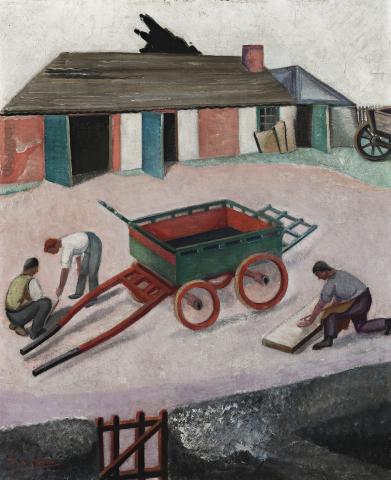THE FARM CART, c.1930
ROY DE MAISTRE
oil on canvas
61.0 x 51.0 cm
signed lower left: R. de Mestre
inscribed verso: De Cher / SLD / 1758 / 65 Chester Place
label attached to stretcher verso: James Bourlet & Sons, Ltd London
Probably Lady Enid de Chair, Sydney and London
Thelma de Chair (first wife of Somerset de Chair, son of Lady Enid de Chair), United Kingdom, prior to 1960
Thence by descent
Private collection, United Kingdom
Bonhams & Goodman, Melbourne, 6 May 2009, lot 26
Private collection, Sydney
Recent paintings by Roi de Mestre, Drawings and pastels by Jean Shepeard, Paintings and rugs by Francis Bacon, 17 Queensbury Mews West, Queensbury Place, Place, London, 4 – 22 November 1930, cat. 6
Roy de Maistre: A retrospective exhibition of paintings and drawings, 1917 – 1960, Whitechapel Art Gallery, London, 1960, illus. pl. II, [caption notes: not exhibited, dated 1929, formerly in the collection of Thelma de Chair]
In the collection of the National Portrait Gallery, Canberra, is a pastel portrait of Roy de Maistre by the actress and artist Jean Shepeard who was associated with the Bloomsbury Group. Dated c.1930, it was almost certainly included in the exhibition she held with De Maistre and the twenty-one year old Francis Bacon in the latter’s South Kensington studio,1 as was The Farm Cart, c.1930 listed as cat. 6 amongst the seven paintings De Maistre presented in the show. Shepeard’s portrait reveals a reflective man, ten years her senior, who was already a recognised name in English art circles having previously exhibited in London in 1923 and in Paris the following year whilst on an a two-year Australian Society of Artists’ Travelling Scholarship. Returning to London permanently in early 1930, he then held a one-man show in July at the Beaux Arts Gallery, an enterprise founded in 1923 and already noted for its advocacy and support of avant-garde art. It is not known exactly how or when De Maistre and Bacon met2 but it is almost certain that their mutual histories charged the attraction, for both men were gay and the sons of prominent racehorse trainers.
Whilst the young Bacon was at the very beginning of his career, De Maistre had many years of training behind him. His 1919 ‘Colour in Art’ exhibition in Sydney with Roland Wakelin was a ground-breaker featuring Australia’s first abstract paintings alongside landscapes executed in heightened non-realistic hues aligned to the artist’s theories on the associations between music and colour. This attraction to formal principles and theory continued to underpin De Maistre’s art throughout his long career, ‘passionately preoccupied with forms and colours and their disposition, never for their own sakes, however, but always as expressions of some extra-aesthetic experience or idea.’3 The Farm Cart is a perfect synthesis of his approach where the actual scene becomes subsumed by the artist’s analytic eye into a series of interconnected geometries, rhythms and colour associations. Initially, it is the reds and greens that lead the eye until the repeated circles join in the trajectory as do the triangular shapes echoed by the similarly shaped foliage above the barn. De Maistre then adds further visual interest with the unusually textured stippling of the yard’s stone wall and in the silver painted frame which, as De Maistre’s biographer Heather Johnson notes, would have been perfectly in sympathy with the stainless steel furniture Bacon displayed in their group exhibition.4
The first owner of The Farm Cart was most likely Lady Enid de Chair, an avid patron of modern art and wife of the then Governor of New South Wales whose vice-regal summer residence was close to the artist’s family home in Moss Vale. De Maistre entered a portrait of the Governor in the 1929 Archibald Prize and they stayed in contact after he returned to England in 1930 where the de Chairs subsequently commissioned him to paint a series of mural panels for their London apartment. Whilst there are small conflicting details regarding the painting’s date,5 it has the tenor of an English or French subject, an argument supported by the inclusion by De Maistre of a Dorset landscape (Bridport Harbour) in the South Kensington show and the existence of three French paintings dated 1930 which were included in his major Retrospective at the Whitechapel Gallery, London, in 1960.6 Although The Farm Cart was not included in this later exhibition, a reproduction of it featured prominently in that catalogue indicating this painting’s continued significance for both the artist and the exhibition’s curator.
1. Paintings by Roi de Mestre. Drawings and Pastels by Jean Shepeard. Paintings and Rugs by Francis Bacon, 17 Queensbury Mews West, Queensbury Place, London, 4 – 22 November 1930. This was the original spelling of De Maistre’s name.
2. It is believed that Bacon introduced Shepeard to De Maistre.
3. Rothenstein, J., ‘Introduction’, Roy De Maistre: a Retrospective Exhibition of Paintings and Drawings 1917 – 1960, Whitechapel Art Gallery, London, 1960, p. 6
4. Heather Johnson. Correspondence with Deutscher and Hackett, 2016.
5. De Maistre is known to have misdated other works in his career. See: Rothenstein, J., Modern English Painters II: Lewis to Moore, Macdonald and Jane’s, London, 1976 (revised edition), p. 257, fn. 2
6. These were: cat.13, Landscape: St. Jean De Luz; cat.14, Landscape: St. Jean De Luz; and cat.15, Fort De Socoa, B.P., all dated 1930.
ANDREW GAYNOR
